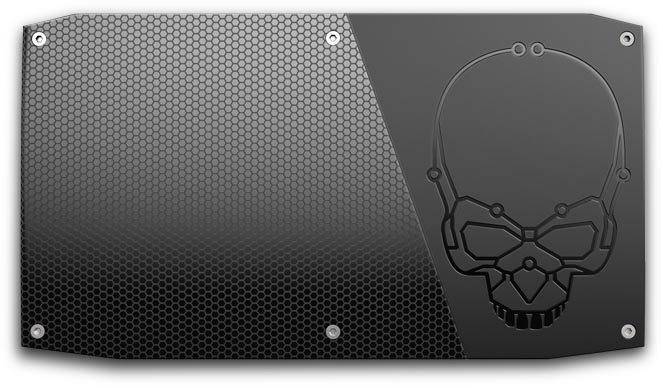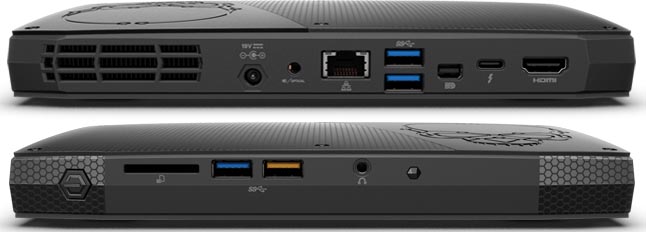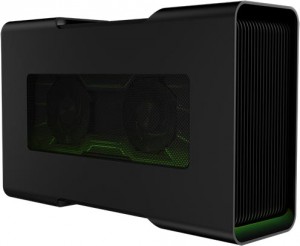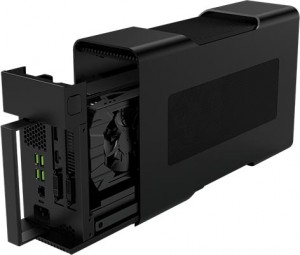- Qualcomm Launches Snapdragon 4 Gen 2 Mobile Platform
- AMD Launches Ryzen PRO 7000 Series Mobile & Desktop Platform
- Intel Launches Sleek Single-Slot Arc Pro A60 Workstation Graphics Card
- NVIDIA Announces Latest Ada Lovelace Additions: GeForce RTX 4060 Ti & RTX 4060
- Maxon Redshift With AMD Radeon GPU Rendering Support Now Available
Intel Unveils Skull Canyon NUC – Can Pair With External Graphics
Intel’s Next Unit of Computing – or NUCs, are delectable tiny PCs with an impressive amount of hardware for the size. Back at CES 2016, Intel was showing off its latest generation of NUCs that utilize the new Skylake CPUs. However, tucked away in the corner was something that didn’t look like a normal NUC – Intel dubbed it the Skull Canyon NUC, and it’s a bit of a beast.
Up until recently, NUCs have been dual-core CPUs in the 15W TDP range, coupled with a modest integrated GPU (you can read our previous review here, and attempts at overclocking). These bare-bone systems are not gaming machines, nor are they particularly suited to heavy workloads. The appeal with them is the extremely compact nature and very low power – they’re the size of a VESA wall mount and can plug into the back of a monitor.
Intel’s latest Skylake-based NUC all had the same familiar chassis, with some tweaks in the hardware, such as support for DDR4, an update to PCIe 3.0 on the M.2 slot, and the new GPU and architecture improvements of the CPU. Skull Canyon on the other hand, is a very clear separation from other NUCs, not only does it look different, it packs in some very different hardware too.

At its heart, Skull Canyon packs in a quad-core i7-6770HQ 45-watt CPU, this accompanied by a Iris Pro 580 GPU (for an IGP, these things are extremely powerful). There is support for up to 32GB of DDR4-2133 RAM (SO-DIMM), and the kicker, two M.2 slots with support for both SATA-based and PCIe 3.0 x4 NVMe SSDs, in RAID 0 – 2-3GB/s (gigabytes) of throughput on storage should be possible.
The interesting stuff doesn’t stop there. In addition to the usual set of 4x USB 3.0 ports (one dedicated to charging) and Gigabit Ethernet, there is an HDMI 2.0 port supporting HDCP 2.2 (for 4K video streaming when it gets here), mini DisplayPort, and finally, the killer feature, a USB Type-C Thunderbolt 3.0 port (capable of 40Gbps).

The Skull Canyon GPU, the Iris Pro 580, is no slouch though. Intel has had a bit of a poor reputation when it comes to its GPUs, but over the last couple years, there has been massive improvements to the architecture. Intel’s current IGP range falls into three groups. The HD series – the 520, which can be found in most desktop CPUs and low-end mobile. It’s the basic model, and fine for driving monitors for work or playing back 4K video, but they will struggle with any kind of modern gaming (but might be fine with older games).
The next step up is the Iris graphics range – these IGPs have more Execution Units (EUs), and are typically clocked faster than the HD series. These are not brilliant gaming GPUs, but they should be able to play some modern games at 720p on medium settings – good enough when you are on the move. The last step is the Iris Pro range, and these GPUs come with 64-128MB of eDRAM, high-speed memory that’s on the chip to help reduce latencies when accessing system memory. Surprisingly, there are some games that can run at 1080p/30fps on medium settings with these GPUs – not super exiting if you’re a PC gamer, but seriously impressive for an integrated GPU. If that’s not enough for you, there is one more trick up this little NUC’s sleeve…
External GPUs
Skull Canyon has been announced alongside something else – the Razer Core, an external GPU enclosure that can hook up to a system over ThunderBolt 3.0. External GPU docks have been on hardware enthusiast’s wish-lists for the last decade, but they’ve been stifled by a number of massive failures, proprietary connectors, unrealistic prices, unreliability, and poor bandwidth. Thunderbolt 3.0 alleviates a number of these issues because of its core focus – it’s effectively an external PCIe connector, providing huge amounts of bandwidth with little latency, over a standardized connector.
The Razer Core isn’t going to be the only external GPU enclosure, ASUS with its ROG XG Station 2 and a number of others have them in development too. While mainly targeted at laptops, these enclosures will work with any device equipped with a TB3.0 port. We haven’t been able to get our hands on one just yet, so we are unsure of the capabilities (they are unlikely to run at native speeds compared to an internal GPU, but they are likely to get close).
So what about pricing?
Intel’s NUCs have always had a bit of price premium to them due to the size and compact nature, so it’s not surprising to see the Skull Canyon NUC going for $650 – which doesn’t include an M.2 SSD, DDR4 RAM, and OS. At a minimum, you will need to get a SATA M.2 SSD and 8GB of DDR4 RAM which will set you back about $120, but it would be worth splashing out for an NVMe SSD and 16GB of RAM. So in total, Skull Canyon could cost between $800-$1000 depending on configuration. The Razor Core external GPU enclosure will set you back a rather hefty $500, which doesn’t include the cost a GPU either. We expect to see the NUC going up for sale some time in May, with no word on the Razer Core.






